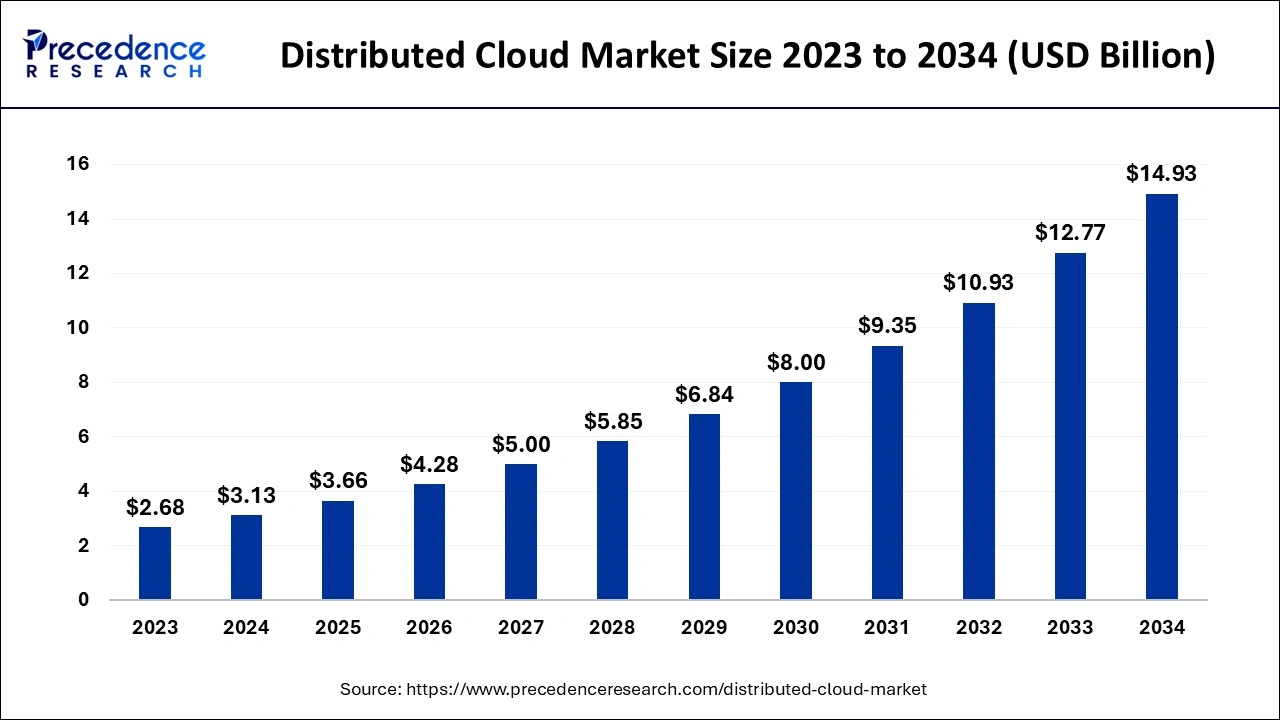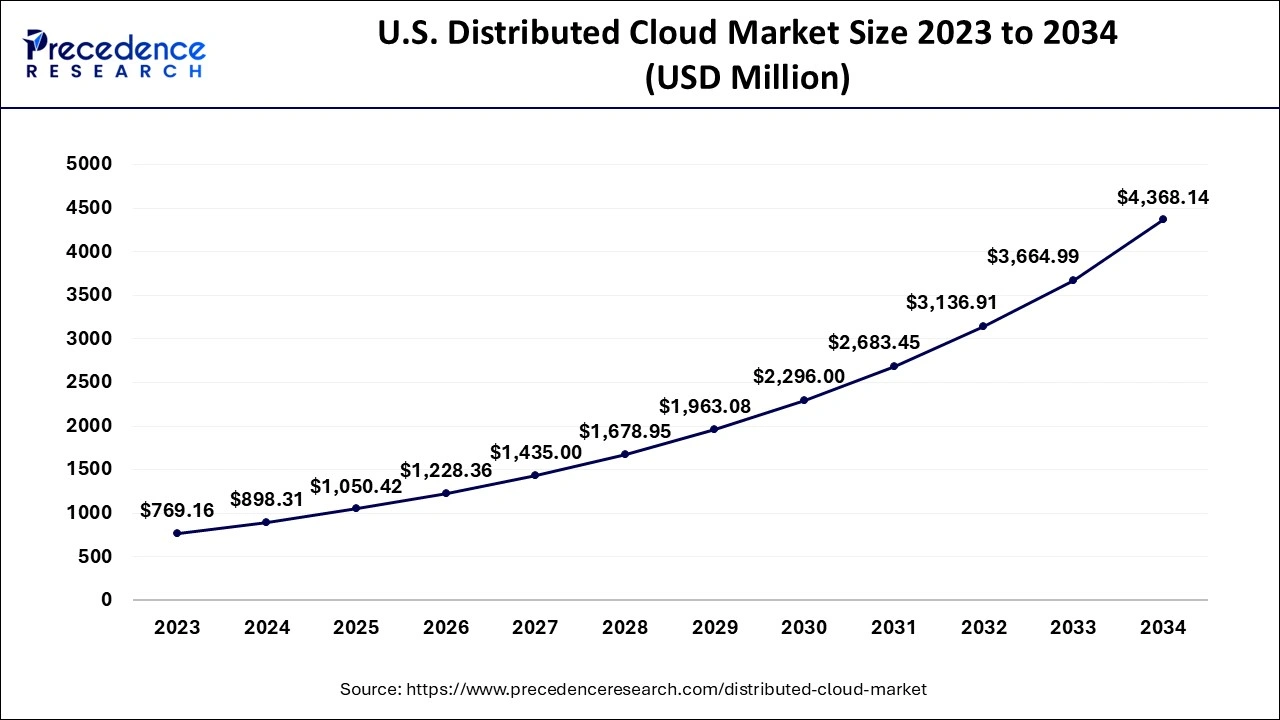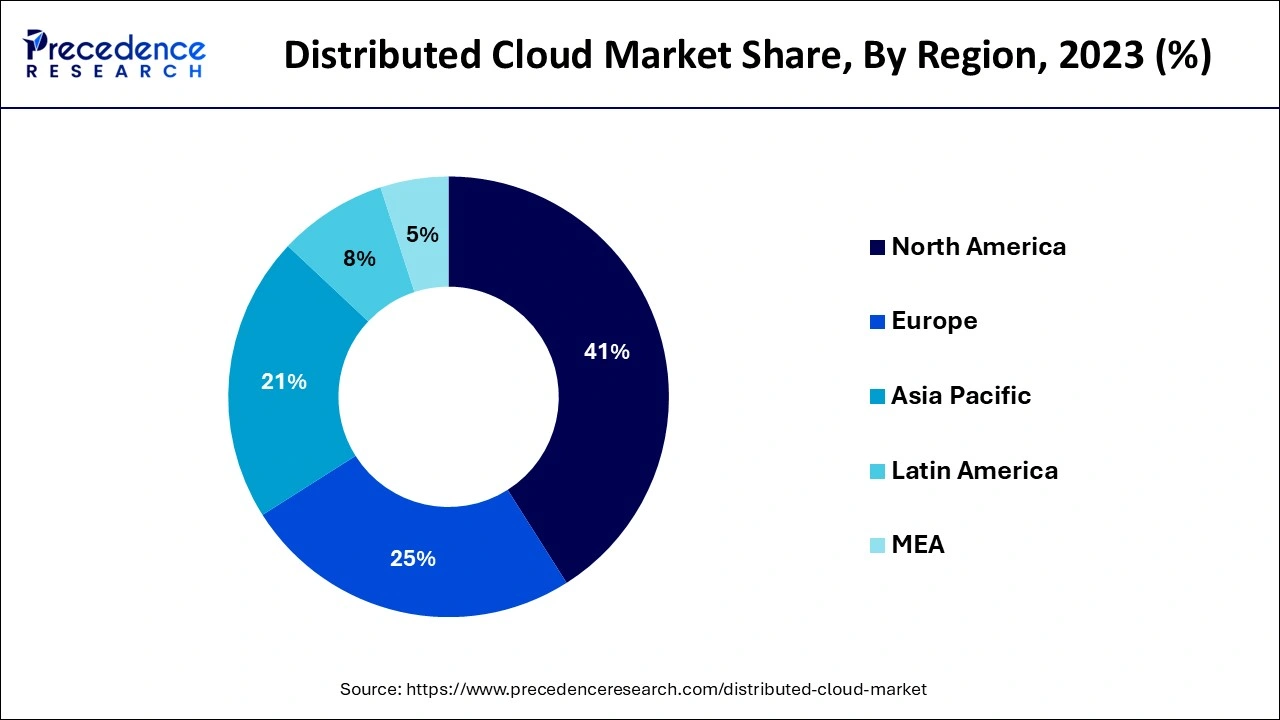List of Contents
What is the Distributed Cloud Market Size?
The global distributed cloudmarket size is calculated at USD 3.66 billion in 2025 and is predicted to increase from USD 4.28 billion in 2026 to approximately USD 14.93 billion by 2034, expanding at a CAGR of 16.90% from 2025 to 2034.

Distributed Cloud Market Key Takeaways
- North America dominated the distributed cloud market share of 41% in 2024.
- By end user, the BFSI segment dominated the market in 2024.
- By service, the data storage segment led the market in 2024.
Market Overview
A distributed cloud is a cloud computing technology application that connects data and applications provided from different geographic locations. A distributed cloud is one in which processing, storage, and networking is placed in a micro-cloud that is separate from the centralized cloud. As a decentralized cloud system, the distributed cloud is closer to the end user. Organizations may decrease latency, network congestion, and the risk of data loss by using a distributed cloud approach.
Furthermore, because data may be stored in the nation where it was created, enterprises can better assure compliance with data sovereignty requirements. Companies are suddenly required to allow a more mobile workforce. With several technical implications and issues, the concept of remote work has developed as a requirement that enterprises must consider. IT leaders from many businesses believe that having a uniform operating experience across the edge and public and private clouds is critical.
The distributed cloud is a cutting-edge and one-of-a-kind strategy in the IT industry. It has a regionally scattered architecture that mostly performs network edge services. Enterprises will be able to monitor and control multiple components thanks to the distributed cloud. Edge apps, apps distributed over many clouds, and various legacy data center apps are among these components. As corporations implement cloud technologies, data theft is becoming a serious problem, and as a result, organizations are attempting to adopt minimal data recovery strategies in order to lose their data. Distributed cloud platforms also provide enterprises with a variety of procedures for data security, such as permission and auditing. Furthermore, data recovery delivers increased dependability. As a result of data recovery, several firms are able to keep their data safe and secure, fueling market growth.
Market Outlook
- Industry Growth Overview: The distributed cloud market is experiencing rapid growth driven by rising demand for low-latency computing, edge data processing, hybrid cloud solutions, and real-time analytics. Additional factors fueling expansion include regulatory requirements for data localization, AI integration, and the ongoing push for digital transformation across industries.
- Global Expansion: The market is growing worldwide as demand for low-latency computing, edge processing, real-time analytics, and secure multi-region cloud deployments across industries increases. Emerging regions present opportunities as governments and businesses invest in digital infrastructure, 5G networks, and cloud adoption to support industrialization, smart cities, and data-driven services.
- Major Investors: Leading investors in the market include corporate and venture capital backers such as M12 (Microsoft's venture fund), Khosla Ventures, Mayfield Fund, and Samsung NEXT, which have supported startups with tens of millions in funding. Additionally, major tech platforms like Microsoft Corporation, Alphabet Inc. (via Google), Amazon Web Services, Inc., and IBM Corporation are heavily investing in edge data centers, distributed cloud architecture, and expanding global infrastructure.
- Startup Ecosystem: The startup ecosystem in the market is dynamic and vibrant, with emerging firms developing edge-native infrastructure, decentralized data platforms, multi-cloud orchestration tools, and AI-optimized computing services fueled by venture capital and global accelerator sponsorships.
Distributed Cloud Market Growth Factors
The rising use of mobile technologies, the increased requirement for minimal data recovery, and the growing use of digitalization, handling higher workloads and data, and better data recovery are some of the main driving reasons for the growth of this market. Furthermore, the ability of public cloud services to transition toward better distributed cloud computing with high end security is fueling the market's growth. However, security worries may stymie the market's expansion. Furthermore, cloud technology adoption, new product releases, and increased government involvement in implementing and promoting cloud technologies are projected to drive market prospects. As corporations implement cloud technologies, data theft is becoming a serious problem, and as a result, organizations are attempting to adopt minimal data recovery strategies in order to lose their data. Distributed cloud platforms also provide enterprises with a variety of procedures for data security, such as permission and auditing. Furthermore, data recovery delivers increased dependability. As a result of data recovery, several firms are able to keep their data safe and secure, fueling market growth.
Distributed cloud solutions assist to increase privacy by storing data in a neighboring or local region; yet, the methods for path control and therefore data storage must travel long even to reach a nearby cloud. Furthermore, when data requires immediate processing and is not kept in public clouds, storage devices owned by data owners can be relocated to another large data center. This technique may raise worries about data ownership and, as a result, raise privacy problems. Many enterprises can see the development and future potential that the distributed cloud may provide, and as a result, they are creating their own distributed clouds. IBM, one of the market's leading participants, has also created the "IBM Cloud Satellite" distributed cloud system, which allows users to access the IBM cloud from anywhere. It may be installed in the cloud or supplied as a service at the edge. Companies must also migrate from old systems to public cloud without physically relocating. Volterra, another major key player in the market has announced the launch of a distributed cloud platform and it offers edge cloud, multi cloud, and network cloud; thus, with these product launches and organizations' migration to multi cloud systems, the market's opportunities are expected to grow in the coming years.
The distributed cloud service market is being driven by rising need for low-cost data backup, storage, and security across all industries, as well as data management requirements arising from greater use of mobile technologies and the promotion of distributed cloud service adoption rates. The distributed cloud service shifts the centralized approach of most public cloud services into a new era of cloud computing technologies. Furthermore, throughout the 2024-2034 forecast periods, the need for high-end security and clearly defined division drives market expansion.
Market Scope
| Report Coverage | Details |
| Market Size in 2025 | USD 3.66 Billion |
| Market Size in 2026 | USD 4.28 Billion |
| Market Size by 2034 | USD 14.93 Billion |
| Growth Rate from 2025 to 2034 | CAGR of 16.90% |
| Base Year | 2024 |
| Forecast Period | 2025 to 2034 |
| Segments Covered | End User, Service Type, Deployment Type, Organizational Size, Application, Geography |
| Regions Covered | North America, Europe, Asia-Pacific, Latin America, and Middle East & Africa |
Segment Insights
End User Insights
The BFSI sector accounted for the biggest proportion of the Global Distributed Cloud Market among all End-Users. The distributed cloud is useful for improving banking processes and screening multiple transactions in seconds, which helps the sector safeguard against financial crimes and improve customer experience.The use of distributed cloud in financial institutions is growing rapidly in order to provide a better client experience. The growing usage of the Internet of Things (IoT) for analyzing enormous data volumes, as well as the growing need for cost-effective cloud computing services and scalable & agile systems to store secret information, is driving the BFSI industry.
On the other hand, the automobile industry is predicted to account for a sizable portion of the Global Distributed Cloud Market. The constantly expanding automotive industry and rising consumer disposable income are fueling the need for integrating automation technologies to improve the customer experience, which is favorably affecting the growth of the automotive distributed cloud market.Furthermore, the rapid adoption of advanced technologies such as Artificial Intelligence, Machine Learning, and the Internet of Things, among others, to improve vehicle efficiency and performance is another critical factor expected to drive demand for distributed cloud technology in the automotive industry.Several firms now claim to be multi-cloud providers, but in reality, they just use individual and multiple clouds. They are also paying several cloud providers. These businesses operate each app on a single cloud provider.
However, the multi-cloud method is distinct. It welcomes the qualities of each cloud provider and allows its customers to take use of each cloud's unique capabilities. Multi-cloud enables organizations to support microservices in a smooth and effective manner. It also improves the availability and flexibility of each app.
Service Type Insights
Data Storage has the greatest market share in the global distributed cloud market. It's because of the fast digitization of records. The distributed cloud spreads people's data over a network, allowing data to be situated closer to end-users and accelerating transfer speed, reducing network congestion and the danger of data loss. Furthermore, because distributed clouds do not rely on centralized data centers or energy-intensive cooling systems for servers, they are a greener storage option. As a result, these properties of distributed cloud are projected to contribute to their rising acceptance for data storage in the next years.This Cloud deployment architecture combines Public Cloud and Private Cloud features. Data and apps may be shared between public and private cloud environments using hybrid cloud. Organizations primarily employ Hybrid Cloud when their on-premise infrastructure needs additional scalability, in order to meet variable business demands. When using the potential of the Public Cloud, organizations may store their sensitive data on their Private Cloud.
This service distribution allows an organization to fulfill highly particular response time and performance needs, regulatory or governance compliance mandates, or other demand that requires cloud infrastructure to be hosted somewhere other than the cloud provider's regular availability zones.The expansion of the internet of things (IoT) and edge computing has been a significant driver of dispersed cloud installations. AI applications that transmit significant volumes of data from edge locations to the cloud require cloud services to be as near to the edge site as feasible, and relocating cloud resources to the edge location itself can considerably improve performance for these applications.
Regional Insights
U.S. Distributed Cloud Market Size and Growth 2025 to 2034
The U.S. distributed cloud market size is evaluated at USD 1050.42 million in 2025 and is predicted to be worth around USD 4368.14 million by 2034, rising at a CAGR of 17.10% from 2025 to 2034.

In the U.S., the market is propelled by a large enterprise sector, advanced edge infrastructure, robust regulatory and data sovereignty frameworks, substantial investment in hyperscale cloud platforms, and early adoption of AI, IoT, and multi-cloud strategies. Strong demand from sectors such as IT, telecom, BFSI, and government, along with early adoption of edge computing and multi-region cloud deployments, further drives the country's dominance in the market.
North America held 41% market share in 2023. Digitization, the existence of a significant number of organizations, data security, data backup, and data recovery are the primary drivers of North America's Distributed Cloud market growth. Furthermore, rising use of cloud computing, internet of things (IOT), and other technologies is boosting market growth. In addition, industrial automation, better customer service for faster enquiries, and other factors are propelling the Distributed Cloud market forward.

Which Factors Influence the Growth of the Market in Asia Pacific?
The growth of the distributed cloud market in Asia Pacific is influenced by increasing adoption of digital transformation initiatives, rising demand for low-latency edge computing, and rapid deployment of 5G networks. Additionally, the expansion of cloud-based services across industries, government support for smart city projects, and stricter data localization regulations are driving investments in distributed cloud infrastructure in the region.
China dominates the Asia-Pacific distributed cloud market due to strong government backing for digital transformation, strict data-sovereignty rules favoring local infrastructure, rapid expansion of 5G and edge networks, substantial investments from domestic cloud giants like Alibaba, Huawei, and Tencent, and increasing demand from manufacturing, BFSI, and public sector organizations for localized, low-latency computing.
Why is Europe Considered a Notably Growing Region in the Distributed Cloud Market?
Europe is considered a notably growing region in the market due to the rising adoption of hybrid and multi-cloud strategies, increasing demand for low-latency computing, and the need for real-time data processing across industries like manufacturing, BFSI, healthcare, and telecom. Stricter data privacy and localization regulations, such as GDPR, are prompting enterprises to invest in distributed cloud solutions that ensure compliance while enhancing performance. Additionally, advancements in 5G infrastructure and edge computing are accelerating cloud deployment across the region. Germany leads the European distributed cloud market, driven by its strong industrial base, high cloud adoption rates, and focus on advanced digital infrastructure.
How Crucial is the Role of Latin America in the Distributed Cloud Market?
Latin America plays a vital role in the market as businesses accelerate digital transformation and seek localized, low-latency computing across different regions. Increasing investments in 5G, edge data centers, and hybrid cloud adoption in sectors like telecom, BFSI, manufacturing, and government are strengthening cloud infrastructure. Supportive regulatory reforms and expansion by global cloud providers further enhance the region's strategic importance.
What are the Latest Trends in Brazil?
Brazil leads the Latin American distributed cloud market because of its high enterprise IT spending, fast growth of 5G and edge infrastructure, strong government support for digital transformation, and widespread adoption of hybrid and multi-cloud environments. Increasing demand from banking, telecom, manufacturing, and public services further cements Brazil's regional leadership.
How Big is the Opportunity for the Market in the Middle East and Africa?
The Middle East and Africa present significant growth opportunities in the distributed cloud market due to the rapid expansion of smart city initiatives, 5G deployment, hyperscale data-center investments, and increasing digital transformation across government, BFSI, healthcare, and energy sectors. The growing demand for localized data processing and compliance with regulations further encourages adoption.
What are the Ongoing Trends in the UAE?
The UAE dominates the distributed cloud market in the Middle East and Africa, driven by strong government digitalization initiatives, the rapid deployment of 5G and edge infrastructure, and early adoption of multi-cloud and AI technologies across different sectors. Major hyperscale cloud providers are increasing their regional data centers in the UAE, supported by favorable regulations, smart-city investments, and high enterprise spending on advanced cloud services.
Distributed Cloud Market Companies
- IBM Corporation: Offers IBM Distributed Cloud, hybrid multicloud platforms, edge computing services, AI-driven workload orchestration, and secure cloud management across public, private, and on-premise environments.
- Amazon Web Services (AWS): Provides AWS Outposts, Local Zones, and Wavelength for distributed cloud deployment, ultra-low-latency computing, edge storage, container services, and hybrid cloud infrastructure.
- Microsoft Corporation: Delivers Azure Arc and Azure Stack for hybrid and distributed cloud environments, enabling unified management, edge processing, AI, and analytics across multi-location cloud deployments.
- VMware Inc.: Offers VMware Cloud Foundation and VMware Edge for distributed cloud application orchestration, multi-cloud networking, virtualization, and secure workload migration across heterogeneous environments.
- Salesforce: Provides Salesforce Hyperforce architecture to distribute CRM workloads across local clouds globally, enabling data residency compliance, secure access, and high-performance cloud delivery.
- CloudSigma: Offers distributed IaaS cloud infrastructure with customizable virtual servers, edge computing services, data-localization capabilities, and multi-region cloud hosting for latency-sensitive applications.
- Google LLP(Google Cloud): Provides Google Distributed Cloud, edge and on-prem solutions supporting Kubernetes, AI/ML workloads, data analytics, and hybrid cloud operations using Anthos and localized infrastructure.
- DigitalOcean: Offers cloud services for SMEs and developers with distributed global data centers, Kubernetes clusters, scalable edge resources, app hosting, and cost-efficient multi-region cloud deployment.
- Pivotal Inc: Offers Pivotal Cloud Foundry (PCF), an open source, multicloud PaaS that enables developers to build, deploy, and manage applications across public, private, and hybrid cloud environments.
- Alibaba Corp.:Through Alibaba Cloud, it provides a distributed cloud platform via solutions like Apsara Stack for hybrid deployments and ACK One, a multi-region container management service for seamless cross-cloud and on-premises operations.
Key market developments
- Google Cloud and banking software provider Temenos partnered in 2019 to provide financial services assistance to companies operating banking software and apps on Google Cloud.
Segments covered in the report
By End User
- Automotive
- BFSI
- Healthcare
- Public Safety
- Government
- Private organization
- Education
By Service Type
- Data Storage
- Networking
- Data Security
- Autonomy
- Others
By Deployment Type
- Public Cloud
- Hybrid Cloud
- Private Cloud
By Organizational Size
- Small & Medium Enterprise
- Large Enterprise
By Application
- Public Resource Computing
- Volunteer Cloud
- Fog/Edge Computing
- Others
By Geography
- North America
- U.S.
- Canada
- Europe
- U.K.
- Germany
- France
- Asia-Pacific
- China
- India
- Japan
- South Korea
- Malaysia
- Philippines
- Latin America
- Brazil
- Rest of Latin America
- Middle East & Africa (MEA)
- GCC
- North Africa
- South Africa
- Rest of the Middle East & Africa
For inquiries regarding discounts, bulk purchases, or customization requests, please contact us at sales@precedenceresearch.com
Frequently Asked Questions
Ask For Sample
No cookie-cutter, only authentic analysis – take the 1st step to become a Precedence Research client



